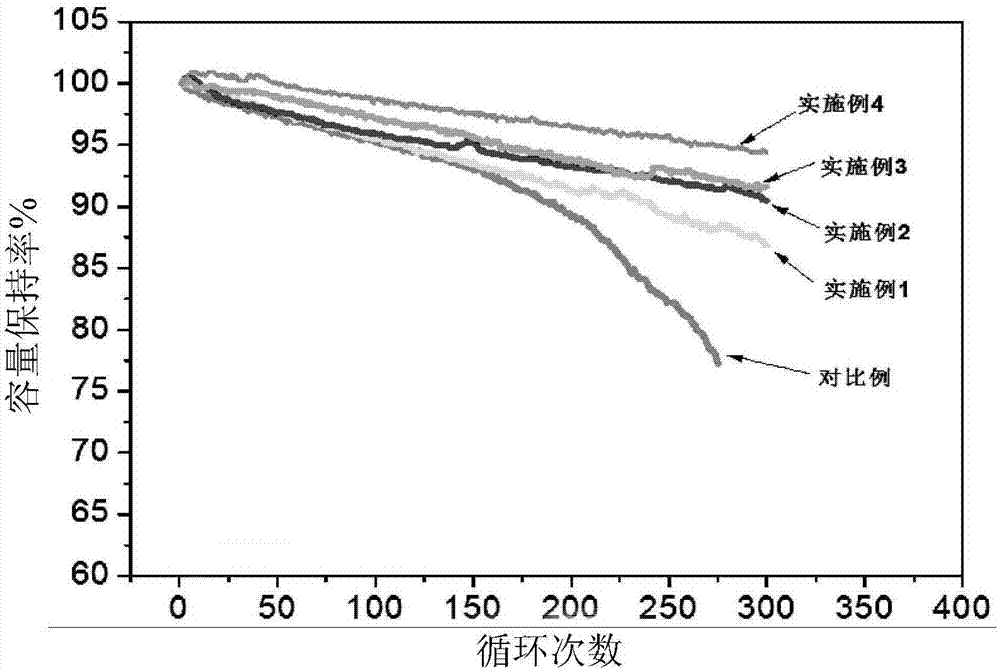Silicon-based anode lithium-ion battery electrolyte
A lithium-ion battery and silicon-based negative electrode technology, applied in secondary batteries, circuits, electrical components, etc., can solve problems such as high consumption, poor temperature resistance, and increased battery impedance, so as to improve cycle performance and reduce LiF content , good film-forming effect
- Summary
- Abstract
- Description
- Claims
- Application Information
AI Technical Summary
Problems solved by technology
Method used
Image
Examples
Embodiment 1
[0030] At room temperature, in a glove box filled with argon, first mix ethylene carbonate, ethyl methyl carbonate, and dimethyl carbonate according to the mass ratio of 1:1:1 to configure the organic solvent; then add fluoroethylene carbonate Esters and three (pentafluorophenyl) boranes are used as film-forming additives, and the addition amounts of the fluoroethylene carbonate and the three (pentafluorophenyl) boranes are respectively 5% and 5% of the mass of the organic solvent. 1%; then add lithium hexafluorophosphate as a lithium salt, and the molar concentration of the lithium hexafluorophosphate in the electrolyte is 1.0mol / L; finally add lithium bisfluorosulfonimide as a functional additive, and the bisfluorosulfonyl Lithium imide is 0.5% of the mass of the organic solvent.
Embodiment 2
[0032] At room temperature, in a glove box filled with argon, first mix ethylene carbonate, ethyl methyl carbonate, and dimethyl carbonate according to the mass ratio of 1:1:1 to configure the organic solvent; then add fluoroethylene carbonate Esters and three (pentafluorophenyl) boranes are used as film-forming additives, and the addition amounts of the fluoroethylene carbonate and the three (pentafluorophenyl) boranes are respectively 5% and 5% of the mass of the organic solvent. 2%; then add lithium hexafluorophosphate as a lithium salt, and the molar concentration of the lithium hexafluorophosphate in the electrolyte is 1.0mol / L; finally add lithium bisfluorosulfonimide as a functional additive, and the bisfluorosulfonyl Lithium imide is 0.5% of the mass of the organic solvent.
Embodiment 3
[0034] At room temperature, in a glove box filled with argon, first mix ethylene carbonate, ethyl methyl carbonate, and dimethyl carbonate according to the mass ratio of 1:1:1 to configure the organic solvent; then add fluoroethylene carbonate Esters and three (pentafluorophenyl) boranes are used as film-forming additives, and the addition amounts of the fluoroethylene carbonate and the three (pentafluorophenyl) boranes are respectively 5% and 5% of the mass of the organic solvent. 4%; then add lithium hexafluorophosphate as a lithium salt, and the molar concentration of the lithium hexafluorophosphate in the electrolyte is 1.0mol / L; finally add lithium bisfluorosulfonimide as a functional additive, and the bisfluorosulfonyl Lithium imide is 0.5% of the mass of the organic solvent.
PUM
 Login to View More
Login to View More Abstract
Description
Claims
Application Information
 Login to View More
Login to View More - R&D
- Intellectual Property
- Life Sciences
- Materials
- Tech Scout
- Unparalleled Data Quality
- Higher Quality Content
- 60% Fewer Hallucinations
Browse by: Latest US Patents, China's latest patents, Technical Efficacy Thesaurus, Application Domain, Technology Topic, Popular Technical Reports.
© 2025 PatSnap. All rights reserved.Legal|Privacy policy|Modern Slavery Act Transparency Statement|Sitemap|About US| Contact US: help@patsnap.com

